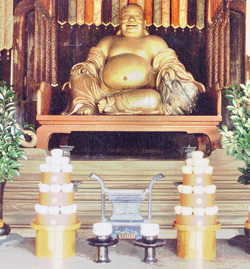Hotei
|
|
- For the Japanese musician, see Tomoyasu Hotei.
Hotei or Bu-Dai (布袋羅漢 (pinyin:bù dài luó hàn) literally cloth sack) is better known as the obese Laughing Buddha. In China, he is called Bu-Dai (Wade-Giles Pu-Tai) or Mi Le Fo (彌勒佛) and dubbed the Loving or Friendly One. He has become incorporated into Buddhist & Shinto culture and is based on an eccentric Chinese Chan (Zen) monk. His image graces many temples, restaurants, and amulets. Hotei has become a deity of contentment and abundance, Taoist in origin. Hotei persists in Japanese folklore as one of the seven happy gods, or shichi fukujin.
| Contents |
History & Art
The Laughing Buddha derives from the time of the Liang Dynasty in China. Hotei is theorized to have begun as a real Buddhist monk in China over 1,000 years ago. He was considered a man of good and loving character. It was said of Hotei's benevolent nature, that he was to be regarded as an incarnation of the bodhisattva soon to be Maitreya (the Future Buddha), but this claim was only allegorical and due to his large protruding stomach & smile, he was caricatured as the "Laughing Buddha."
The image of Hotei is almost always seen carrying a cloth or linen sack (that which never empties) which is filled with many precious items, including rice plants (indicating wealth), candy for children, food, or the woes of the world. Sometimes it can be filled with children as they are seen as some of those precious items of this world. His duty is patron of the weak, poor and children. In some scenes he may be found sitting on a cart drawn by boys, or wielding a fan called an oogi (said to be a "wish giving" fan -- in the distant past, this type of fan was used by the aristocracy to indicate to vassals that their requests would be granted).
The statue depicts a stout, smiling or laughing bald man in robes with a largely exposed pot belly stomach symbolic for happiness, good luck, and plenitude. The stomach is also considered the seat of the soul in Chinese mythology and so the large stomach can be taken as an allegory for Hotei's Open Heartedness. Some sculptures have small children at his feet. Another item that is usually seen with the Hotei figure, is a begging bowl; to represent his Buddhist nature. All of these images display Hotei as a wandering monk who goes around and takes the sadness from people of this world. He most certainly is a loving and cheerful character, strikingly similar to Santa Claus in the West and is a common statuette found in homes and businesses in China and Japan.
Religion
One belief surrounding the figure of Hotei in popular folklore is that if a person is to rub his belly, it brings forth wealth, good luck, and prosperity. This belief however does not form part of any Buddhist doctrine. He is often admired for his happiness, plenitude, and supposedly wisdom of contentment.
Chinese Buddhists have adopted Hotei as the Laughing Buddha into the Mahayana Buddhist pantheon and his image may be found in the first hall of many Buddhist monasteries. Ch'an temples will usually have Hotei located at their entrances & courtyards. Hotei was attributed the title of Maitreya Buddha because of a poem allegedy written on his deathbed that read.
"Maitreya Maitreya, everyone is looking for Maitreya. They do not realise that he is already here."
At the time of the Liang Dynasty the figure of Maitreya was very popular due to political turmoil and a great many Buddhists venerated Maitreya in the hope that he would soon come to spread the dharma. Buddhists at the time took the poem to mean that Hotei had been Maitreya all along and thus the title was attributed to him in popular folklore. Most modern Buddhists now view Hotei's poem as an allegory for seeking one's salvation in the present moment rather than looking to an imagined future.
In Japan, Hotei is also seen as a one of the Shichi Fukujin, the Seven Japanese Shinto-gods of Luck. He is supposedly the only member of the seven based on an actual person. Back when Buddhist missionary monks were delivering the message & way of Gautama Buddha onto the islands of Japan, they devised a method to more efficiently reach the local Shinto inhabitants. By manifesting Buddhist principles, with Shinto Kami, the monks were successful. Kami are seen as Shinto gods and were worshiped as such. The Buddhist monastics were able to better communicate their ideology to Japanese natives by using the Kami's as examples in common Buddhist practice. Thus, Buddhism became very widely accepted in Japan and from one of these manifestations, came Hotei.
Western Invasion
Recently, Hotei statues, statuettes and amulets have become relatively well known in Western lands. From the new enthusiasm has grown much ignorance due to misunderstandings of culture & factual history. A common misconception is the false acquaintance between the Laughing Buddha and Gautama Buddha, the founder of Buddhism and at times the random enthusiast cannot tell the difference between the two. Hotei is also referred to as the patron saint of restaurateurs, fortunetellers and bartenders. When one over eats and over drinks, jokingly friends attribute it to Hotei's influence.
Template:Buddhism2de:Hotei ja:布袋尊
External Links
Truetao.org Information on Hotei within Taoism (http://www.taoism.net/living/1999/199907.htm) An anectdote regarding Hotei (http://www.thesegoto11.com/zen/index.php?story=12)

